Health & Social Care: Practices, Discoveries, and Non-Statutory Bodies
VerifiedAdded on 2023/06/10
|7
|1539
|279
Report
AI Summary
This report provides an overview of health and social care, comparing practices from the mid-1800s to the present day. It highlights the significant impact of scientific discoveries, such as antibiotics and vaccines, pioneered by figures like Alexander Fleming and Edward Jenner, and evaluates their relevance to modern care provision. The report also examines the evolving understanding of infection causes since the 1850s and assesses the contributions and efficacy of non-statutory organizations in delivering health services, emphasizing their role in care coordination and public health initiatives. The analysis concludes that advancements in health and social care have greatly improved quality of life and disease prevention, underscoring the importance of continuous innovation and collaborative efforts.
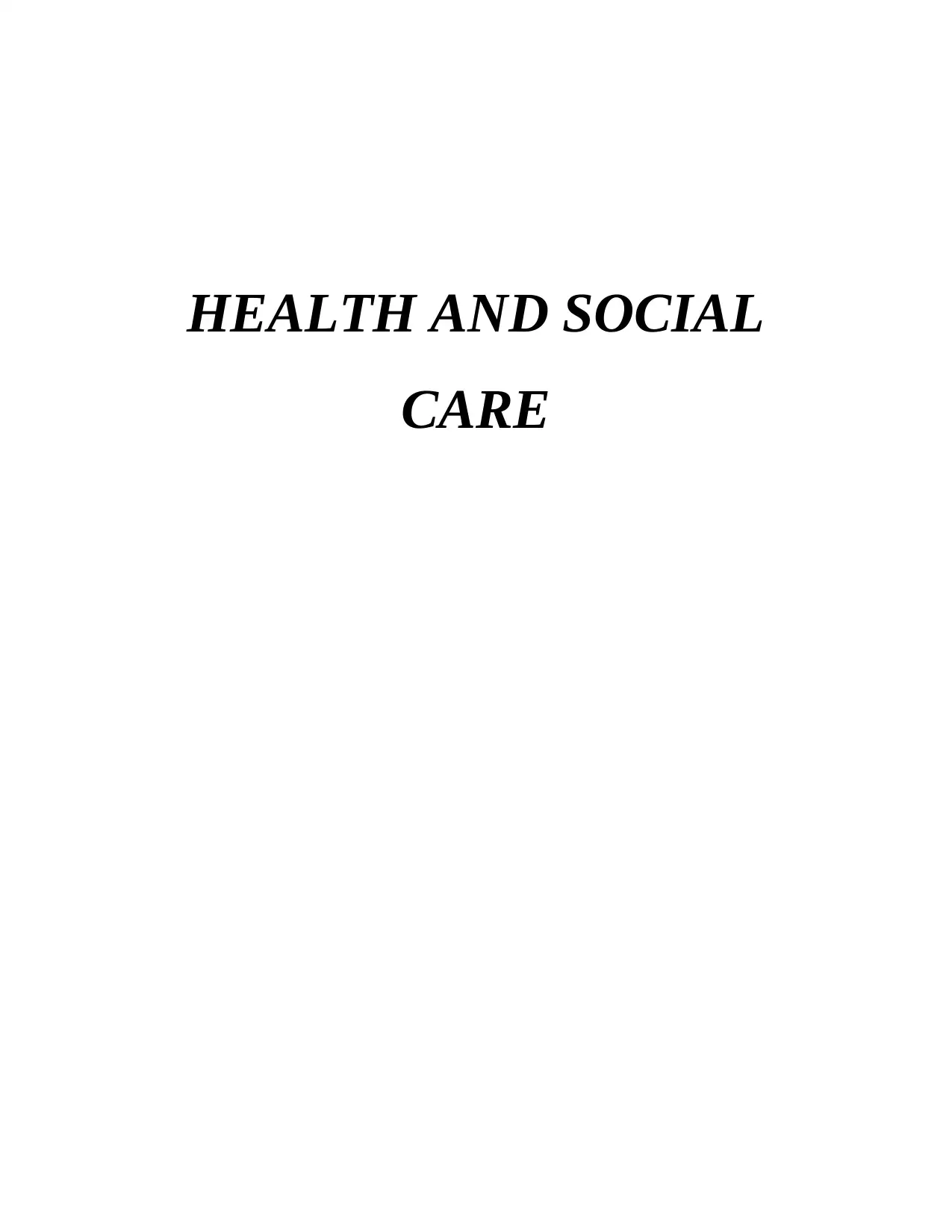
HEALTH AND SOCIAL
CARE
CARE
Paraphrase This Document
Need a fresh take? Get an instant paraphrase of this document with our AI Paraphraser
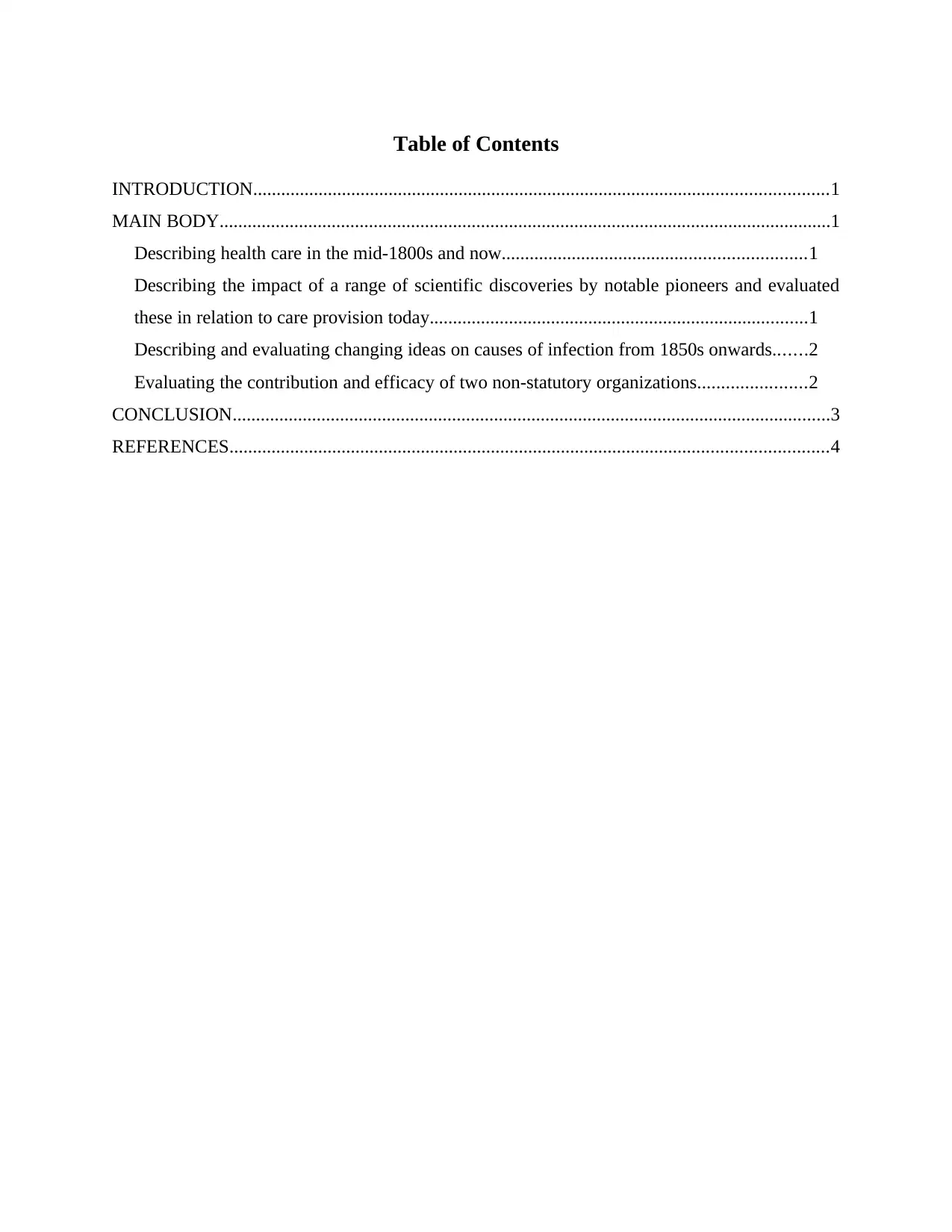
Table of Contents
INTRODUCTION...........................................................................................................................1
MAIN BODY...................................................................................................................................1
Describing health care in the mid-1800s and now.................................................................1
Describing the impact of a range of scientific discoveries by notable pioneers and evaluated
these in relation to care provision today.................................................................................1
Describing and evaluating changing ideas on causes of infection from 1850s onwards.......2
Evaluating the contribution and efficacy of two non-statutory organizations.......................2
CONCLUSION................................................................................................................................3
REFERENCES................................................................................................................................4
INTRODUCTION...........................................................................................................................1
MAIN BODY...................................................................................................................................1
Describing health care in the mid-1800s and now.................................................................1
Describing the impact of a range of scientific discoveries by notable pioneers and evaluated
these in relation to care provision today.................................................................................1
Describing and evaluating changing ideas on causes of infection from 1850s onwards.......2
Evaluating the contribution and efficacy of two non-statutory organizations.......................2
CONCLUSION................................................................................................................................3
REFERENCES................................................................................................................................4
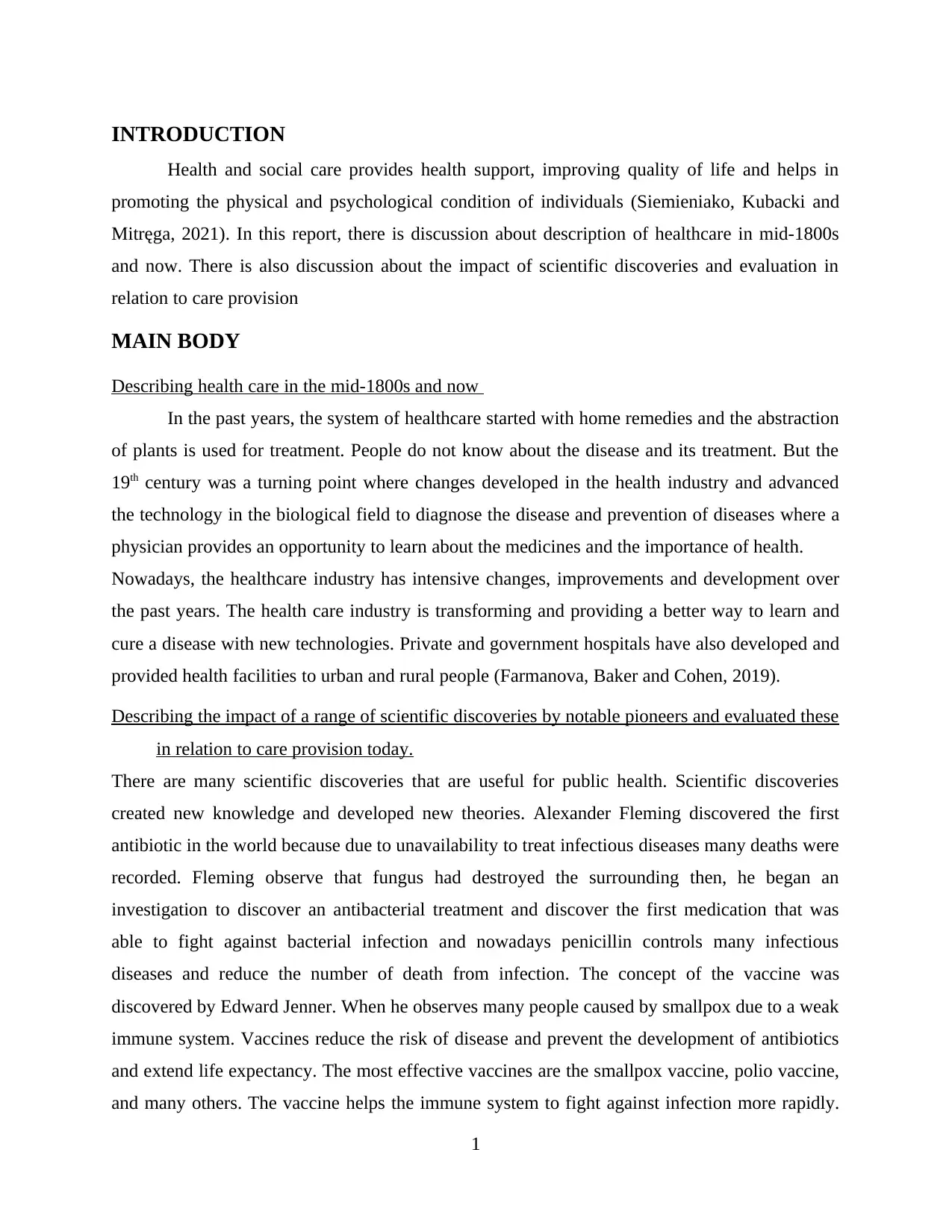
INTRODUCTION
Health and social care provides health support, improving quality of life and helps in
promoting the physical and psychological condition of individuals (Siemieniako, Kubacki and
Mitręga, 2021). In this report, there is discussion about description of healthcare in mid-1800s
and now. There is also discussion about the impact of scientific discoveries and evaluation in
relation to care provision
MAIN BODY
Describing health care in the mid-1800s and now
In the past years, the system of healthcare started with home remedies and the abstraction
of plants is used for treatment. People do not know about the disease and its treatment. But the
19th century was a turning point where changes developed in the health industry and advanced
the technology in the biological field to diagnose the disease and prevention of diseases where a
physician provides an opportunity to learn about the medicines and the importance of health.
Nowadays, the healthcare industry has intensive changes, improvements and development over
the past years. The health care industry is transforming and providing a better way to learn and
cure a disease with new technologies. Private and government hospitals have also developed and
provided health facilities to urban and rural people (Farmanova, Baker and Cohen, 2019).
Describing the impact of a range of scientific discoveries by notable pioneers and evaluated these
in relation to care provision today.
There are many scientific discoveries that are useful for public health. Scientific discoveries
created new knowledge and developed new theories. Alexander Fleming discovered the first
antibiotic in the world because due to unavailability to treat infectious diseases many deaths were
recorded. Fleming observe that fungus had destroyed the surrounding then, he began an
investigation to discover an antibacterial treatment and discover the first medication that was
able to fight against bacterial infection and nowadays penicillin controls many infectious
diseases and reduce the number of death from infection. The concept of the vaccine was
discovered by Edward Jenner. When he observes many people caused by smallpox due to a weak
immune system. Vaccines reduce the risk of disease and prevent the development of antibiotics
and extend life expectancy. The most effective vaccines are the smallpox vaccine, polio vaccine,
and many others. The vaccine helps the immune system to fight against infection more rapidly.
1
Health and social care provides health support, improving quality of life and helps in
promoting the physical and psychological condition of individuals (Siemieniako, Kubacki and
Mitręga, 2021). In this report, there is discussion about description of healthcare in mid-1800s
and now. There is also discussion about the impact of scientific discoveries and evaluation in
relation to care provision
MAIN BODY
Describing health care in the mid-1800s and now
In the past years, the system of healthcare started with home remedies and the abstraction
of plants is used for treatment. People do not know about the disease and its treatment. But the
19th century was a turning point where changes developed in the health industry and advanced
the technology in the biological field to diagnose the disease and prevention of diseases where a
physician provides an opportunity to learn about the medicines and the importance of health.
Nowadays, the healthcare industry has intensive changes, improvements and development over
the past years. The health care industry is transforming and providing a better way to learn and
cure a disease with new technologies. Private and government hospitals have also developed and
provided health facilities to urban and rural people (Farmanova, Baker and Cohen, 2019).
Describing the impact of a range of scientific discoveries by notable pioneers and evaluated these
in relation to care provision today.
There are many scientific discoveries that are useful for public health. Scientific discoveries
created new knowledge and developed new theories. Alexander Fleming discovered the first
antibiotic in the world because due to unavailability to treat infectious diseases many deaths were
recorded. Fleming observe that fungus had destroyed the surrounding then, he began an
investigation to discover an antibacterial treatment and discover the first medication that was
able to fight against bacterial infection and nowadays penicillin controls many infectious
diseases and reduce the number of death from infection. The concept of the vaccine was
discovered by Edward Jenner. When he observes many people caused by smallpox due to a weak
immune system. Vaccines reduce the risk of disease and prevent the development of antibiotics
and extend life expectancy. The most effective vaccines are the smallpox vaccine, polio vaccine,
and many others. The vaccine helps the immune system to fight against infection more rapidly.
1
⊘ This is a preview!⊘
Do you want full access?
Subscribe today to unlock all pages.

Trusted by 1+ million students worldwide
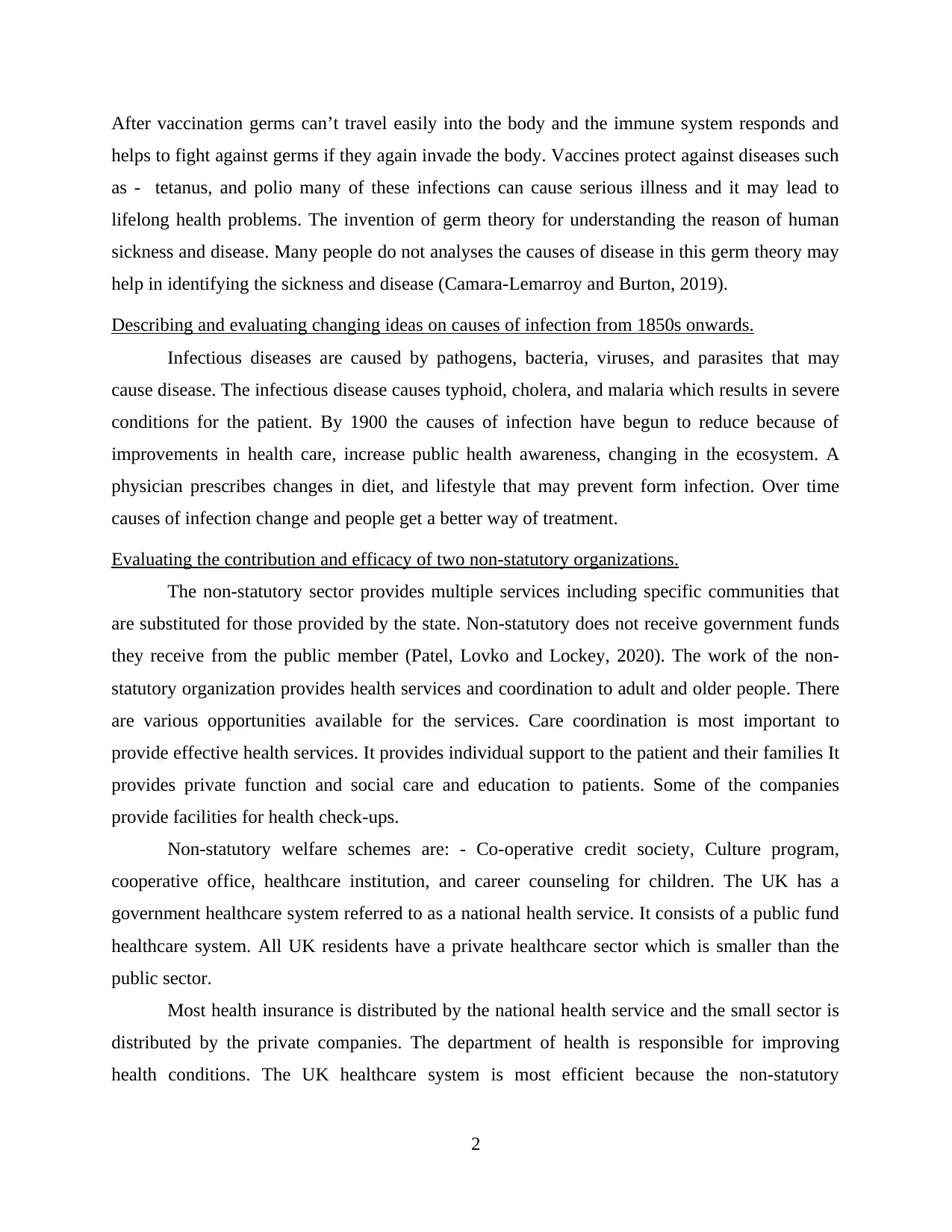
After vaccination germs can’t travel easily into the body and the immune system responds and
helps to fight against germs if they again invade the body. Vaccines protect against diseases such
as - tetanus, and polio many of these infections can cause serious illness and it may lead to
lifelong health problems. The invention of germ theory for understanding the reason of human
sickness and disease. Many people do not analyses the causes of disease in this germ theory may
help in identifying the sickness and disease (Camara-Lemarroy and Burton, 2019).
Describing and evaluating changing ideas on causes of infection from 1850s onwards.
Infectious diseases are caused by pathogens, bacteria, viruses, and parasites that may
cause disease. The infectious disease causes typhoid, cholera, and malaria which results in severe
conditions for the patient. By 1900 the causes of infection have begun to reduce because of
improvements in health care, increase public health awareness, changing in the ecosystem. A
physician prescribes changes in diet, and lifestyle that may prevent form infection. Over time
causes of infection change and people get a better way of treatment.
Evaluating the contribution and efficacy of two non-statutory organizations.
The non-statutory sector provides multiple services including specific communities that
are substituted for those provided by the state. Non-statutory does not receive government funds
they receive from the public member (Patel, Lovko and Lockey, 2020). The work of the non-
statutory organization provides health services and coordination to adult and older people. There
are various opportunities available for the services. Care coordination is most important to
provide effective health services. It provides individual support to the patient and their families It
provides private function and social care and education to patients. Some of the companies
provide facilities for health check-ups.
Non-statutory welfare schemes are: - Co-operative credit society, Culture program,
cooperative office, healthcare institution, and career counseling for children. The UK has a
government healthcare system referred to as a national health service. It consists of a public fund
healthcare system. All UK residents have a private healthcare sector which is smaller than the
public sector.
Most health insurance is distributed by the national health service and the small sector is
distributed by the private companies. The department of health is responsible for improving
health conditions. The UK healthcare system is most efficient because the non-statutory
2
helps to fight against germs if they again invade the body. Vaccines protect against diseases such
as - tetanus, and polio many of these infections can cause serious illness and it may lead to
lifelong health problems. The invention of germ theory for understanding the reason of human
sickness and disease. Many people do not analyses the causes of disease in this germ theory may
help in identifying the sickness and disease (Camara-Lemarroy and Burton, 2019).
Describing and evaluating changing ideas on causes of infection from 1850s onwards.
Infectious diseases are caused by pathogens, bacteria, viruses, and parasites that may
cause disease. The infectious disease causes typhoid, cholera, and malaria which results in severe
conditions for the patient. By 1900 the causes of infection have begun to reduce because of
improvements in health care, increase public health awareness, changing in the ecosystem. A
physician prescribes changes in diet, and lifestyle that may prevent form infection. Over time
causes of infection change and people get a better way of treatment.
Evaluating the contribution and efficacy of two non-statutory organizations.
The non-statutory sector provides multiple services including specific communities that
are substituted for those provided by the state. Non-statutory does not receive government funds
they receive from the public member (Patel, Lovko and Lockey, 2020). The work of the non-
statutory organization provides health services and coordination to adult and older people. There
are various opportunities available for the services. Care coordination is most important to
provide effective health services. It provides individual support to the patient and their families It
provides private function and social care and education to patients. Some of the companies
provide facilities for health check-ups.
Non-statutory welfare schemes are: - Co-operative credit society, Culture program,
cooperative office, healthcare institution, and career counseling for children. The UK has a
government healthcare system referred to as a national health service. It consists of a public fund
healthcare system. All UK residents have a private healthcare sector which is smaller than the
public sector.
Most health insurance is distributed by the national health service and the small sector is
distributed by the private companies. The department of health is responsible for improving
health conditions. The UK healthcare system is most efficient because the non-statutory
2
Paraphrase This Document
Need a fresh take? Get an instant paraphrase of this document with our AI Paraphraser
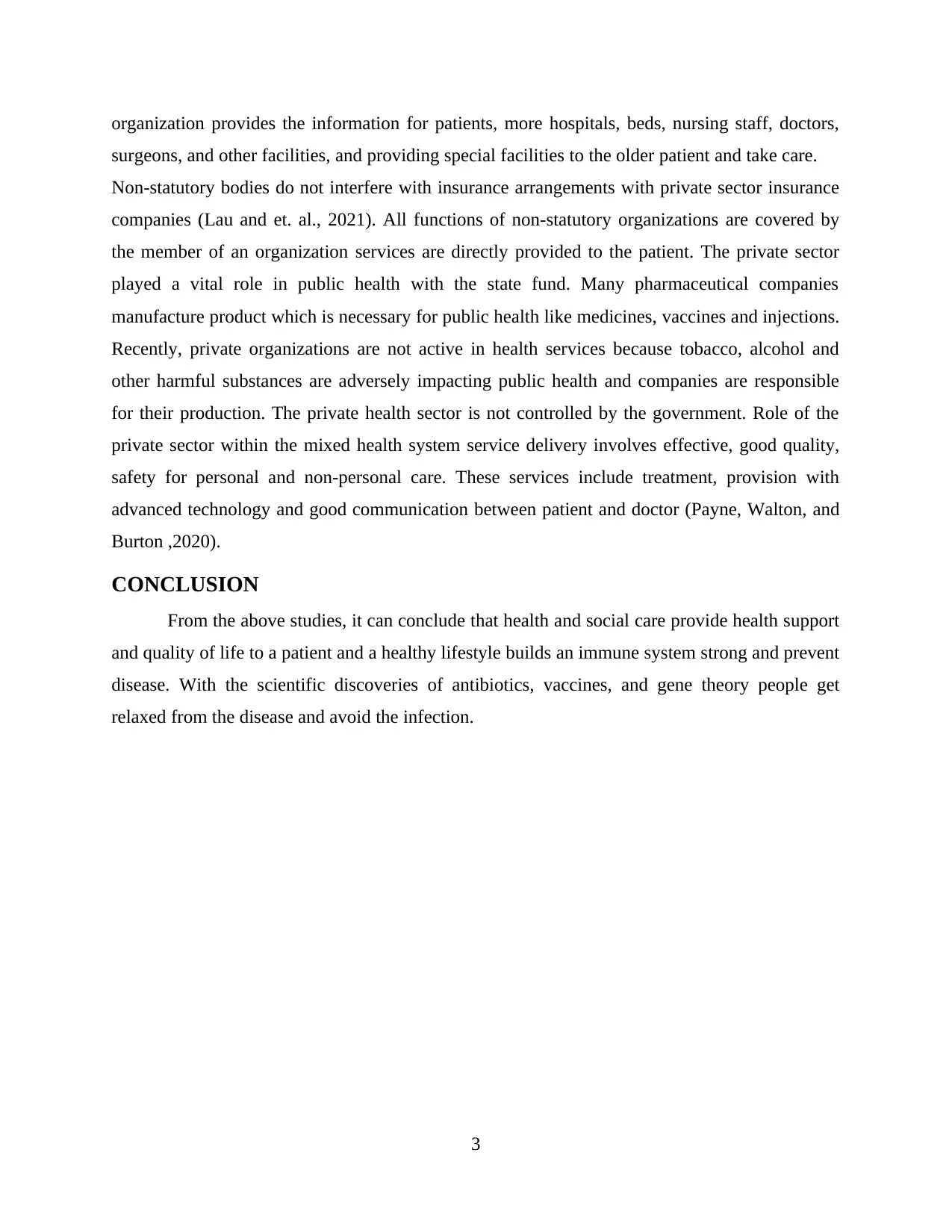
organization provides the information for patients, more hospitals, beds, nursing staff, doctors,
surgeons, and other facilities, and providing special facilities to the older patient and take care.
Non-statutory bodies do not interfere with insurance arrangements with private sector insurance
companies (Lau and et. al., 2021). All functions of non-statutory organizations are covered by
the member of an organization services are directly provided to the patient. The private sector
played a vital role in public health with the state fund. Many pharmaceutical companies
manufacture product which is necessary for public health like medicines, vaccines and injections.
Recently, private organizations are not active in health services because tobacco, alcohol and
other harmful substances are adversely impacting public health and companies are responsible
for their production. The private health sector is not controlled by the government. Role of the
private sector within the mixed health system service delivery involves effective, good quality,
safety for personal and non-personal care. These services include treatment, provision with
advanced technology and good communication between patient and doctor (Payne, Walton, and
Burton ,2020).
CONCLUSION
From the above studies, it can conclude that health and social care provide health support
and quality of life to a patient and a healthy lifestyle builds an immune system strong and prevent
disease. With the scientific discoveries of antibiotics, vaccines, and gene theory people get
relaxed from the disease and avoid the infection.
3
surgeons, and other facilities, and providing special facilities to the older patient and take care.
Non-statutory bodies do not interfere with insurance arrangements with private sector insurance
companies (Lau and et. al., 2021). All functions of non-statutory organizations are covered by
the member of an organization services are directly provided to the patient. The private sector
played a vital role in public health with the state fund. Many pharmaceutical companies
manufacture product which is necessary for public health like medicines, vaccines and injections.
Recently, private organizations are not active in health services because tobacco, alcohol and
other harmful substances are adversely impacting public health and companies are responsible
for their production. The private health sector is not controlled by the government. Role of the
private sector within the mixed health system service delivery involves effective, good quality,
safety for personal and non-personal care. These services include treatment, provision with
advanced technology and good communication between patient and doctor (Payne, Walton, and
Burton ,2020).
CONCLUSION
From the above studies, it can conclude that health and social care provide health support
and quality of life to a patient and a healthy lifestyle builds an immune system strong and prevent
disease. With the scientific discoveries of antibiotics, vaccines, and gene theory people get
relaxed from the disease and avoid the infection.
3
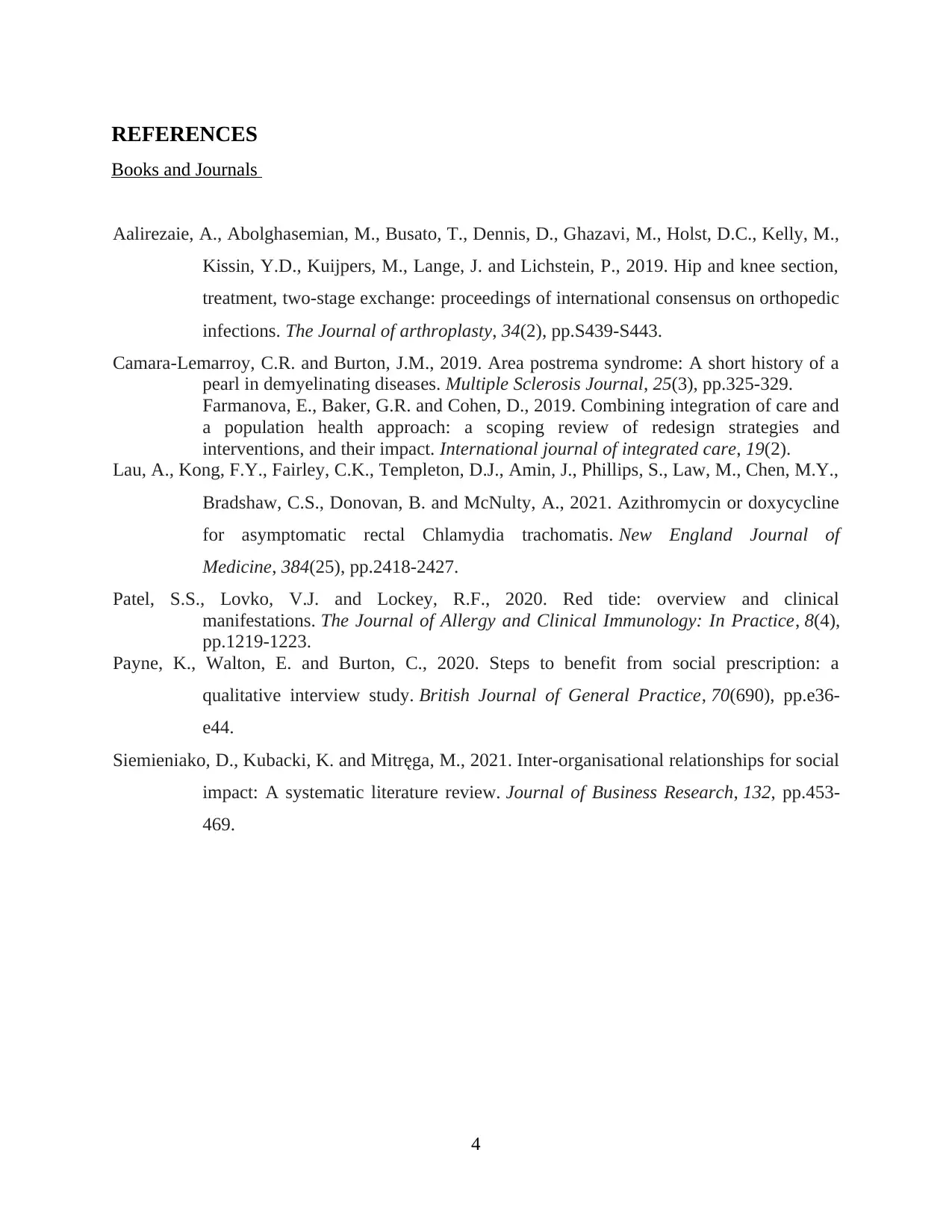
REFERENCES
Books and Journals
Aalirezaie, A., Abolghasemian, M., Busato, T., Dennis, D., Ghazavi, M., Holst, D.C., Kelly, M.,
Kissin, Y.D., Kuijpers, M., Lange, J. and Lichstein, P., 2019. Hip and knee section,
treatment, two-stage exchange: proceedings of international consensus on orthopedic
infections. The Journal of arthroplasty, 34(2), pp.S439-S443.
Camara-Lemarroy, C.R. and Burton, J.M., 2019. Area postrema syndrome: A short history of a
pearl in demyelinating diseases. Multiple Sclerosis Journal, 25(3), pp.325-329.
Farmanova, E., Baker, G.R. and Cohen, D., 2019. Combining integration of care and
a population health approach: a scoping review of redesign strategies and
interventions, and their impact. International journal of integrated care, 19(2).
Lau, A., Kong, F.Y., Fairley, C.K., Templeton, D.J., Amin, J., Phillips, S., Law, M., Chen, M.Y.,
Bradshaw, C.S., Donovan, B. and McNulty, A., 2021. Azithromycin or doxycycline
for asymptomatic rectal Chlamydia trachomatis. New England Journal of
Medicine, 384(25), pp.2418-2427.
Patel, S.S., Lovko, V.J. and Lockey, R.F., 2020. Red tide: overview and clinical
manifestations. The Journal of Allergy and Clinical Immunology: In Practice, 8(4),
pp.1219-1223.
Payne, K., Walton, E. and Burton, C., 2020. Steps to benefit from social prescription: a
qualitative interview study. British Journal of General Practice, 70(690), pp.e36-
e44.
Siemieniako, D., Kubacki, K. and Mitręga, M., 2021. Inter-organisational relationships for social
impact: A systematic literature review. Journal of Business Research, 132, pp.453-
469.
4
Books and Journals
Aalirezaie, A., Abolghasemian, M., Busato, T., Dennis, D., Ghazavi, M., Holst, D.C., Kelly, M.,
Kissin, Y.D., Kuijpers, M., Lange, J. and Lichstein, P., 2019. Hip and knee section,
treatment, two-stage exchange: proceedings of international consensus on orthopedic
infections. The Journal of arthroplasty, 34(2), pp.S439-S443.
Camara-Lemarroy, C.R. and Burton, J.M., 2019. Area postrema syndrome: A short history of a
pearl in demyelinating diseases. Multiple Sclerosis Journal, 25(3), pp.325-329.
Farmanova, E., Baker, G.R. and Cohen, D., 2019. Combining integration of care and
a population health approach: a scoping review of redesign strategies and
interventions, and their impact. International journal of integrated care, 19(2).
Lau, A., Kong, F.Y., Fairley, C.K., Templeton, D.J., Amin, J., Phillips, S., Law, M., Chen, M.Y.,
Bradshaw, C.S., Donovan, B. and McNulty, A., 2021. Azithromycin or doxycycline
for asymptomatic rectal Chlamydia trachomatis. New England Journal of
Medicine, 384(25), pp.2418-2427.
Patel, S.S., Lovko, V.J. and Lockey, R.F., 2020. Red tide: overview and clinical
manifestations. The Journal of Allergy and Clinical Immunology: In Practice, 8(4),
pp.1219-1223.
Payne, K., Walton, E. and Burton, C., 2020. Steps to benefit from social prescription: a
qualitative interview study. British Journal of General Practice, 70(690), pp.e36-
e44.
Siemieniako, D., Kubacki, K. and Mitręga, M., 2021. Inter-organisational relationships for social
impact: A systematic literature review. Journal of Business Research, 132, pp.453-
469.
4
⊘ This is a preview!⊘
Do you want full access?
Subscribe today to unlock all pages.

Trusted by 1+ million students worldwide

5
1 out of 7
Related Documents
Your All-in-One AI-Powered Toolkit for Academic Success.
+13062052269
info@desklib.com
Available 24*7 on WhatsApp / Email
![[object Object]](/_next/static/media/star-bottom.7253800d.svg)
Unlock your academic potential
Copyright © 2020–2025 A2Z Services. All Rights Reserved. Developed and managed by ZUCOL.



